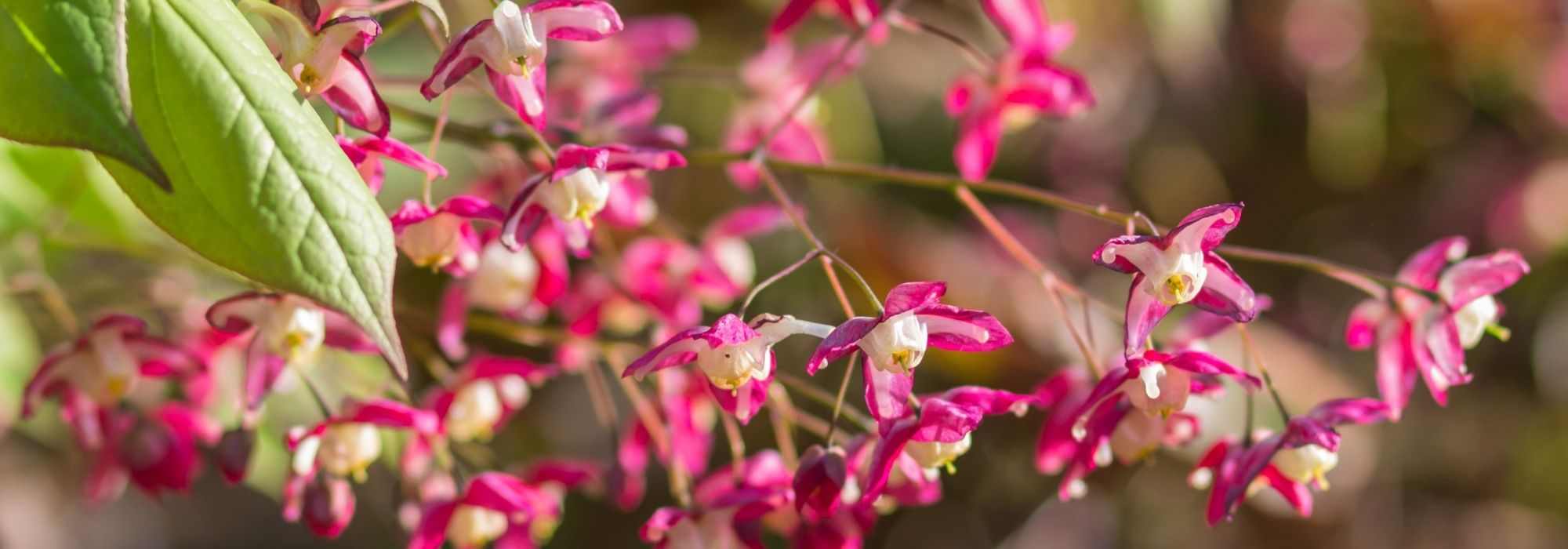
Choosing a spike
Our buying guide
Contents
Hardy woodland plant, epimedium, also known as Elf Flower or barrenwort, is a perennial renowned for its delicate and enchanting spring flowering. This genus comes in various colours and features flowers in different shapes, star-shaped or bell-shaped, with large or small spurs. With a groundcover or more upright habit, epimediums do not all bloom at the same time in spring. If you are determined to acquire an Epimedium, discover our buying guide to help you choose based on different criteria and uses!
According to height
Creeping or upright, epimediums can vary in height depending on the species and varieties. We can distinguish three size categories:
Small epimediums under 30 cm tall
Among the smallest epimediums, very useful as groundcover plants to fill gaps at the front of borders, we can mention Epimedium brachyrrhizum, varieties of Epimedium youngianum ‘Merlin’, ‘Niveum’ and ‘Roseum’, Epimedium rubrum and its variety ‘Galadriel’ forming carpets 20 cm high, spreading to about 30 cm wide. Note that some varieties of Epimedium grandiflorum, such as ‘Purple Pixie’, ‘Shiho’ and ‘Akebono’ are around 20-25 cm tall.
Medium epimediums 30 to 40 cm tall
The species and varieties of this size are very numerous. With a height of about 30 cm, we find notably: Epimedium pubigerum, theEpimedium davidii, theEpimedium pauciflorum, theEpimedium stellulatum ‘Wudang Star’ and Epimedium alpinum. Varieties of Epimedium grandiflorum, Epimedium x versicolor, Epimedium pinnatum as well as many hybrids like theEpimedium ‘Sphinx Twinkler’ and thehybrid epimedium ‘Pink Elf’ are of the same size.
The flowers of the elves Epimedium acuminatum, Epimedium warleyense and its variety ‘Ellen Willmott’ and Epimedium elongatum form homogeneous bushes of 40 cm in all directions.
TheEpimedium perralchicum ‘Frohnleiten‘ and theEpimedium leptorrhizum grow up to about 40 cm tall and tend to spread up to 50-60 cm wide.
Large epimediums over 40 cm tall
There are epimediums that can exceed 40 cm in height, such as theEpimedium dolichostemon which forms a well-formed clump up to 60 cm tall and spreading up to 40 cm wide.

Epimedium rubrum and Epimedium alpinum
According to the colour of the flowers
Epimediums offer a wide range of shades: white, yellow, orange, pink, red, and purple. Some elf flowers are bicoloured or multicoloured, displaying varying degrees of contrast between the flower’s centre, spurs, petals, or sepals.
White-flowered Epimediums:
The elf flower can be a pure white as seen in Epimedium youngianum ‘Niveum’ and Epimedium stellatum ‘Wudang Star’, but it can also reveal a cream white like in Epimedium pubigerum. The hybrid Epimedium ‘Domino’ features white flowers with a pink centre. The flowers of Epimedium pauciflorum white display some subtle pink reflections.
Yellow or Orange-flowered Epimediums:
Yellow or orange epimediums come in various warm shades.
- Epimedium perralchicum ‘Frohnleiten’ and Epimedium davidii are among the epimediums with bright yellow flowers.
- In a lighter shade of sulphur yellow or cream, we find Epimedium ‘Flower Of Sulphur’, Epimedium x versicolor ‘Sulphureum’, Epimedium pinnatum ssp colchicum, Epimedium ‘Sphinx Twinkler’, and Epimedium elongatum.
- Between yellow and orange, the variety ‘Amber Queen’ bears yellow flowers with an amber and brown centre. In coppery orange and yellow tones, the blooms of Epimedium warleyense and warleyense ‘Ellen Willmott’ and Epimedium pubigerum ‘Orangekönigin’ are very similar.

Epimedium pauciflorum, Epimedium perralchicum ‘Frohnleiten’ and Epimedium X warleyense ‘Orangekönigin’
Pink, Purple, or Red-flowered Epimediums
With epimediums, it is not always easy to define the exact colour of their flowers. Sometimes the shade of the elf flowers is a clever mix of pink and purple or between pink and red.
- Epimedium grandiflorum ‘Akebono’ displays a pale pink colour.
- Completely pink, Epimedium acuminatum, Epimedium ‘Asiatic Hybrid’, and the hybrid ‘Pink Elf’ feature contrasting flowers light pink with a dark pink centre.
- For example, Epimedium youngianum ‘Roseum’ and ‘Merlin’ are dressed in a rather pale violet-pink, just like Epimedium brachyrrhizum. The large-flowered elf flower Epimedium grandiflorum, along with the varieties ‘Lilafee’ and ‘Beni-kujaku’ from this species, reveal lilac flowers.
- Finally, the darkest in our collection are Epimedium grandiflorum ‘Red Beauty’ with its violet and fuchsia pink flowers and Epimedium grandiflorum ‘Shiho’ producing purple violet flowers.
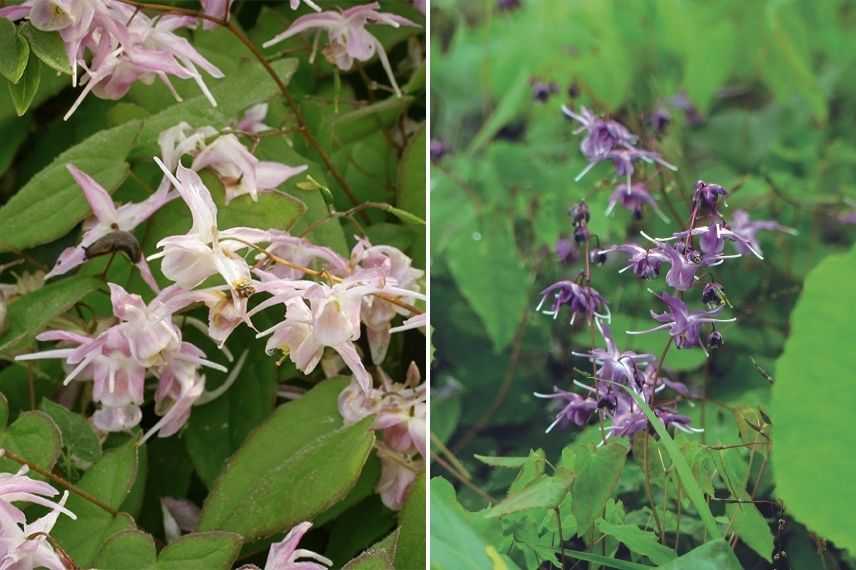
Epimedium grandiflorum ‘Akebono’ and Epimedium grandiflorum ‘Lilafee’ (photo PBK)
Bicoloured or Multicoloured Epimediums
Among the epimediums offering bicoloured blooms, we find Epimedium rubrum and its variety ‘Galadriel’ whose pink or red sepals serve as a backdrop for the white petals and spurs, as well as Epimedium alpinum with red and yellow flowers. The Epimedium grandiflorum ‘Purple Pixie’ in purple features white spurred petals. Conversely, Epimedium dolichostemon with pure white sepals reveals petals with burgundy red spurs.
Very original and surprising, Epimedium x versicolor ‘Cupreum’ offers a multicoloured bloom of pale pink and yellow, enhanced with coppery touches. Finally, Epimedium pinnatum ‘Black Sea’ flowers from April to May in shades of salmon pink, pale yellow, and amber.
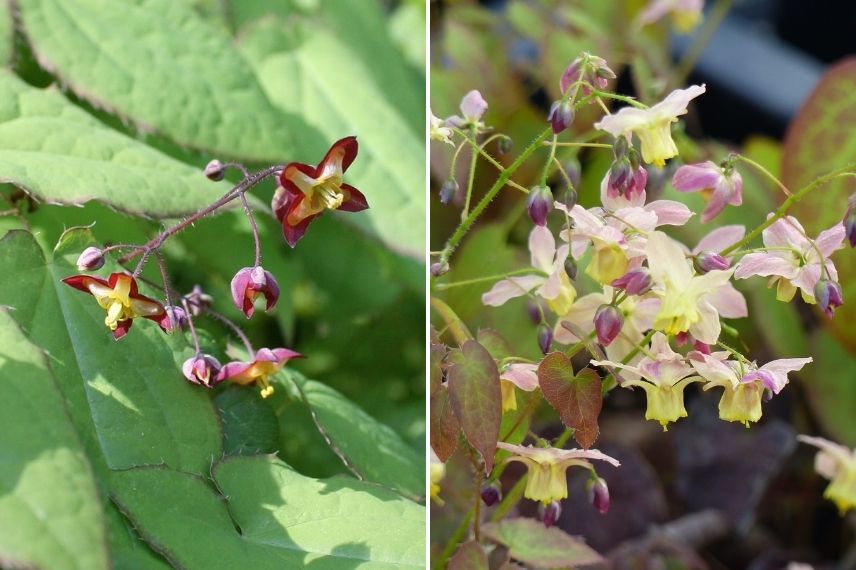
Epimedium alpinum (photo Anneli Salo) and Epimedium versicolor ‘Cupreum’
Discover other Epimedium - Barrenwort
View all →Available in 2 sizes
Available in 2 sizes
Available in 1 sizes
Available in 1 sizes
Available in 1 sizes
Available in 1 sizes
Available in 1 sizes
Available in 1 sizes
Available in 1 sizes
Available in 2 sizes
According to the shape of the flower
Generally, the inflorescences are pendulous and clustered in a spike at the end of flexible flower stems that stand tall above the foliage.
- Very often, the flowers of the epimediums are curved towards the ground and equipped with fine, more or less hooked spurs. They sometimes resemble spiders. The heart of the flower is prominent, as seen in the Epimedium davidii, the Epimedium grandiflorum, the Epimedium x versicolor ‘Sulphureum’, the Epimedium ‘Flowers of Sulphur’, and the Epimedium ‘Sphinx Twinkler’.
- Some species and varieties have particularly developed, long or wide sepals, giving an impression of winged flowers. This is the case with the hybrid ‘Pink Elf’, with Epimedium youngianum ‘Niveum’ and ‘Roseum’, with Epimedium ‘Asiatic Hybrids’, with Epimedium brachyrrhizum, or even with Epimedium leptorrhizum.
- The flowers of the Epimedium alpinum and the Epimedium rubrum are small and composed of 4 petals perfectly imbricate in a calyx of 4 sepals.
- Less sophisticated, the Epimedium youngianum ‘Merlin’ and the Epimedium pubigerum show bell-shaped flowers. The Epimedium pinnatum ‘Black Sea’, the Epimedium warleyense, the Epimedium perralchicum ‘Frohnleiten’, and the Epimedium stellulatum ‘Wudang Star’ all offer single flowers.
Note that Epimedium grandiflorum means “large-flowered epimedium.” Indeed, its flowers can reach up to 4-5 cm in diameter with their long spurs.

Epimedium grandiflorum (Kenpei), Epimedium ‘Pink Elf’, Epimedium alpinum (photo Esther Westerveld – Flickr) and Epimedium warleyense (photo Chris Mealy)
According to the persistence of foliage
Many epimediums are evergreen, such as the species Epimedium pinnatum, Epimedium x versicolor, Epimedium x warleyense, Epimedium stellulatum, Epimedium pubigerum, Epimedium pauciflorum, Epimedium leptorrhizum, Epimedium dolichostemon, Epimedium alpinum…
Some exceptions are included in our collection. Epimedium davidii, Epimedium grandiflorum, and Epimedium youngianum have deciduous foliage.
According to the flowering period
Elf flowers generally bloom in April-May. However, there are some species and varieties that show their flowers earlier in the year:
- Epimedium dolichostemon is the earliest, blooming in January!
- Epimedium x versicolor ‘Cupreum’ offers a bicolour pink and yellow flowering in March
- Epimedium pinnatum ssp colchicum bears yellow flowers from March to April
- Epimedium stellulatum ‘Wudang Star’ brightens the garden with its white flowers and yellow stamens.
Finally, some epimediums can extend their flowering until June, notably Epimedium davidii in yellow and Epimedium pauciflorum in white, both of which develop their flowers from May.

Epimedium pinnatum ssp. colchicum
According to the use
Growing mainly in woodlands, epimedium is used differently depending on its ability to spread and its height, but always in shaded to semi-shaded areas.
Species and varieties that spread easily through their rootstocks are ideal for covering a bank, edging a path, or the front of a flower bed, or simply for dressing the base of trees or a hedge of bushes. With a spreading habit, Epimedium rubrum, Epimedium leptorrhizum, Epimedium x versicolor ‘Sulfureum’, and Epimedium perralchicum ‘Frohnleiten’ are excellent groundcovers.
It is possible to plant epimedium in a cool shady rockery. If your soil tends to dry out, opt for the species warleyense and perralchicum, which tolerate dry soils better than other species.
The taller and upright epimediums are better suited for flowering beds. Medium-sized specimens, such as Epimedium pubigerum, Epimedium davidii, Epimedium pauciflorum, and the various varieties of Epimedium grandiflorum, integrate easily within a perennial bed. At the back of the bed, favour larger epimediums like Epimedium dolichostemon, reaching up to 60 cm in height.
Finally, the fairy flower can also be grown in pots. The epimediums ‘Lilafee’, ‘Domino’, ‘Black Sea’, and the varieties of Epimedium youngianum are stunning in flowering pots to brighten up balconies and terraces.

Epimediums in light woodland, as groundcover or in beds
For further reading
- All our range of epimediums on our site
- To learn more, check our sheet Epimedium, flower of the elves: plant, grow and maintain
- Discover our ideas to associate epimediums in the garden
- Subscribe!
- Contents
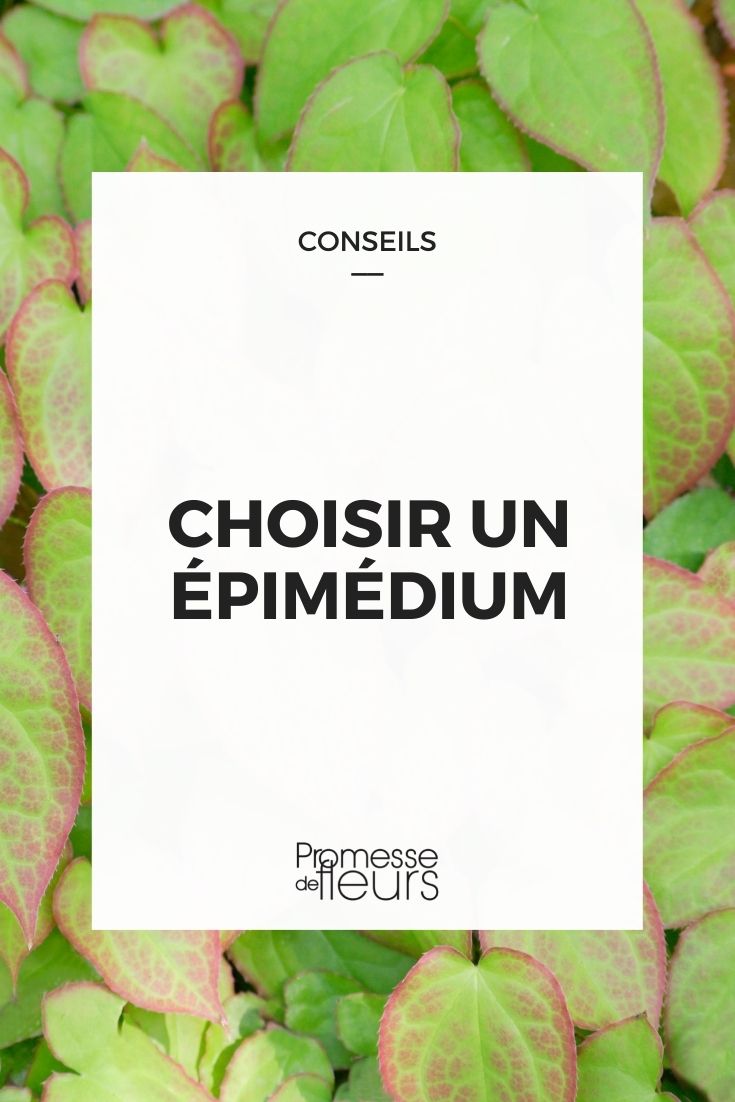































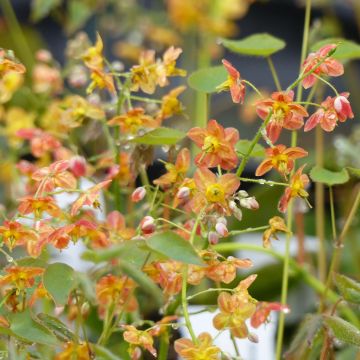
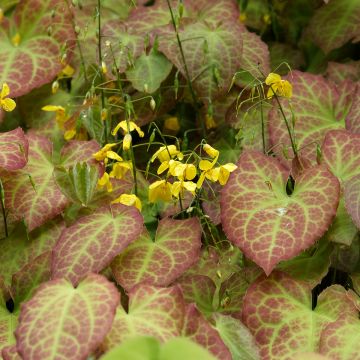
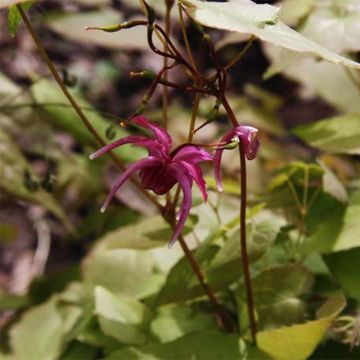
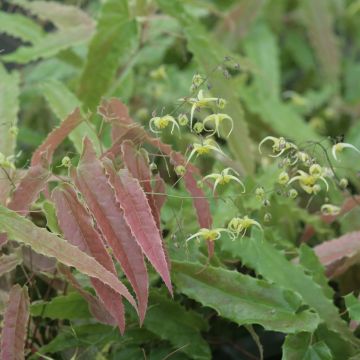
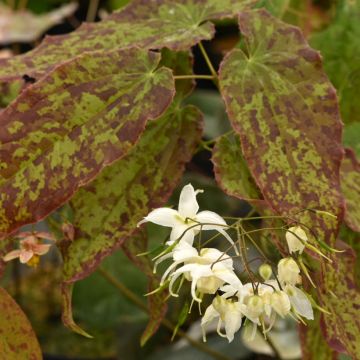

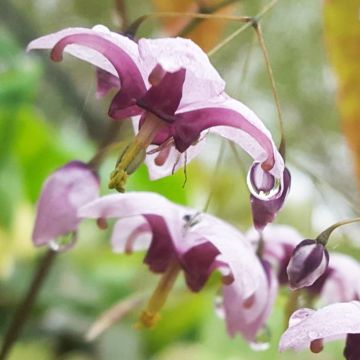
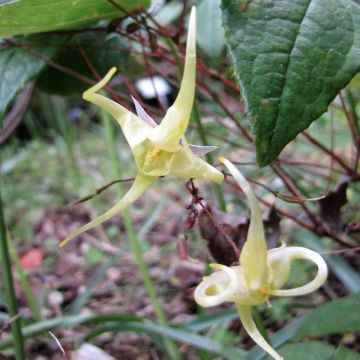
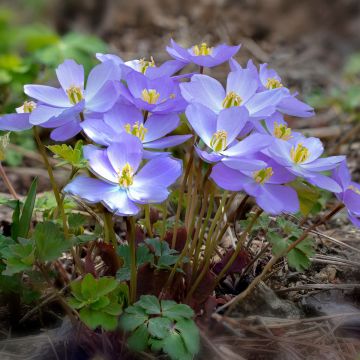
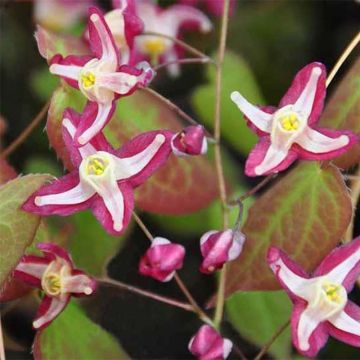
Comments